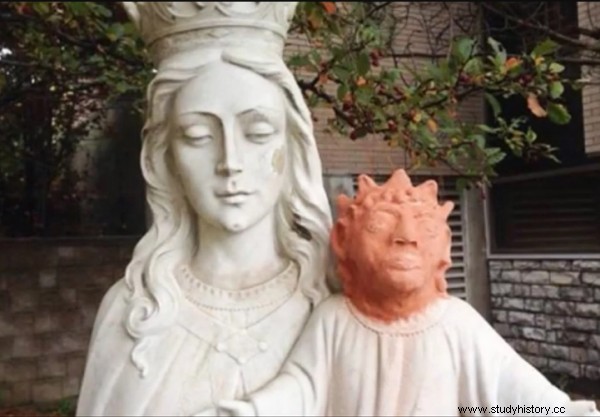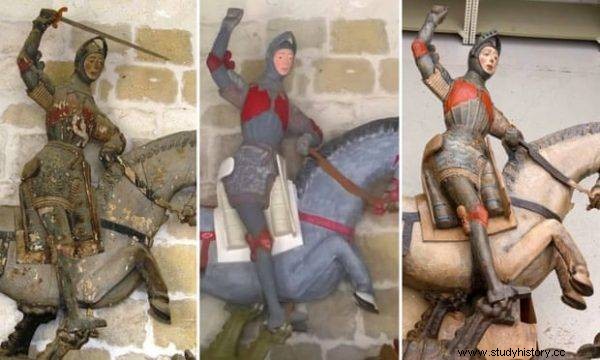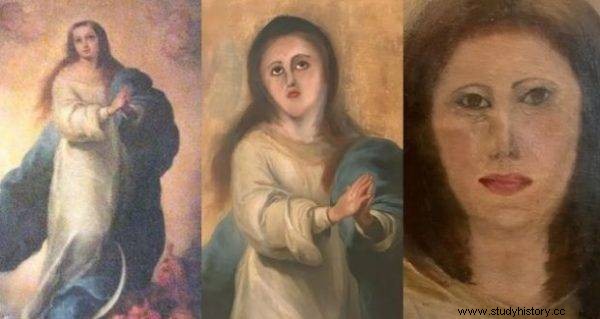Amateurs often do the restoration of works of art. Effect? Sometimes he goes beyond his wildest expectations. We present the worst renovations ever.
The aim of the conservation and restoration of monuments is to keep the object in the best technical condition. Intervention should be as minimal as possible. An important rule is also to ensure the reversibility of the process, i.e. a return to the state before the fixes, if necessary . However, when looking at the restored monuments presented below, one can get the impression that their contractors either forgot or did not even take the above rules into account. Some people apparently prefer to create their own works than to focus on what they should do.
1. Ecce Homo - Zaragoza, Spain
Ecce Homo (Latin here is a man) is a fresco that can be admired in Zaragoza, Spain. It was painted by the Spanish painter Elías García Martínez in 1930 and presents Jesus wearing a crown of thorns.

The disfigured fresco quickly ... became a meme, gaining a new name - "Ecce Mono" (Latin here is a monkey)
The deteriorating condition of the fresco worried a parishioner, Cecilia Giménez, who was an amateur artist. In 2012, she suggested to the church's parish priest that he would undertake the renovation of the work, to which the man readily agreed. The woman started work, but even before it was finished, she went on a short vacation. The local history association then had an opportunity to evaluate the restoration process. What they saw must have scared them. They quickly banned the artist from further work, and the disfigured fresco just as quickly ... became a meme , gaining a new name - "Ecce Mono" (Latin here's a monkey ) . On the one hand, the unsuccessful renovation was criticized by art historians and conservators, but on the other, it attracted crowds of curious tourists eager to see this specific attraction. There is nothing bad that would not turn out to be good?
2. Virgin Mary and Baby Jesus - Sudbury, Canada
The sculpture depicting the Virgin Mary holding baby Jesus in her arms is in a Canadian city. In 2015, vandals destroyed the statue, tearing off Jesus' head. The torn fragment was lost, and any repair would cost the church several tens of thousands of dollars. Help was then offered by local artist Heather Wise. Although she had not only time, but also photos, which were supposed to facilitate her work, did not cope with this task .

The new head of Baby Jesus was made of a different material than the whole sculpture - terracotta, and besides, it looked more like a gargoyle than a small child.
The new head of Baby Jesus was made of a different material than the whole sculpture - terracotta, and besides it looked more like a gargoyle than a small child . In addition, after a few days, it began to melt under the influence of rain, which only worsened her appearance. Fortunately, the original headpiece was found a few months later and the monstrous dummy could be said goodbye.
3. Saint George and the dragon - Estella, Spain
In the church of St. Michael in Estella in the north of Spain is a 16th-century wooden sculpture that depicts Saint George sitting on a horse in armor. In 2018, it was found that the monument needed renovation. The restaurant was commissioned by one of the city's studios, which assigned a task to a local art teacher. The bright colors of the paints used made Saint George - as ruthless internet users noticed - resembling a cartoon character . It was decided to remove the new paint and carry out another renovation. After all, the sculpture does not look too bad anymore, although has been spent on restoring it instead of EUR 10,000 with EUR 33,000. Spain is definitely out of luck with restoring works of art.

The bright colors of the paints used made Saint George - as merciless internet users noticed - resemble a cartoon character.
4. Mary Immaculate Conception - Valencia, Spain
Mary Immaculate Conception is a painting painted by the baroque painter Bartolomé Esteban Murill , originating in Spain. The work was created in the second half of the 17th century. The original can be seen in the Prado Museum in Madrid but a copy of it is in the collection of a private collector from Valencia. The owner decided to renew his valuable acquisition and asked for help from ... a furniture renovator . The collector paid 1,200 euros for the service.

Mary Immaculate Conception is a painting painted by the baroque painter Bartolomé Esteban Murill
When he saw the result of the work, he must have regretted every coin he issued. Mary's new face looked nothing like the original. The client asked the contractor to restore the painting to its original condition. After the second attempt, as you can easily guess, Mary completely lost her human features and looked even worse , resembling a caricature rather than a biblical character. Spain probably should work on a law regulating the restoration and conservation of works of art.
5. Saint Anthony of Padua - Soledad, Colombia
The wooden statue of Saint Anthony of Padua, located in the church in Soledad, Colombia, was made in the 17th century. It has probably not been refreshed since then, and has lost its original colors. In 2018, it was finally decided to restore the sculpture. After the work was completed, the parishioners did not express their admiration. They quickly noticed that the saint they had prayed to for many years looked as if ... he was wearing makeup - painted eyes, lips, cheeks and even adjusted eyebrows. The Baby Jesus, held by Saint Anthony in her arms, also has a new, lipstick face.
The parishioners did not like the refreshed image of the saint, directly said he looked "too effeminate". The reason for this effect could be inadequate paints and techniques that should not be used when renovating a polychrome wooden sculpture. Interestingly, the artist hired to work for this order received approximately - converted - PLN 1,300. The conclusion is that you cannot save money on the renovation of works of art.
Bibliography :
- Research on painting technologies and techniques. Conservation of works of art, copy , collective study, Toruń 2007.
- Gibert Armengol V., López J., Restoration of wooden objects , Warsaw 2009.
- Pascual E., Patino M., Painting Conservation , Warsaw 2004.
- Sieniawska-Kuras A., Potocki P., Renovation of architectural elements , Krosno 2012.
- Szolginia W., Architecture , Warsaw 1992.
